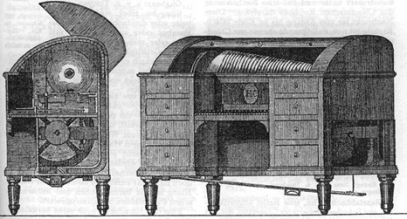The keyed harmonica

keyed harmonica, anonymous engraving,
Allgemeine Musikalische Zeitung (AMZ), 1st vol., 1799.
One of the many attempts to produce a keyed harmonica was published in the AMZ . Today no historic keyed harmonica exists any more (the last was destroyed in Leipzig museum, war loss).
music sample:
(excerpt) Johann Gottlieb Naumann: Sonata g minor
played by Bruno Kliegl
Instrument: keyed harmonica based on an instrument by Sascha Reckert
The glass harmonica, invented by Benjamin Franklin could be considered THE instrument of the "sensitivity style" ("Empfindsamkeit") like none other. The ethereal sound pleased the public, harmonica virtuosos (among them many women) enjoyed europe-wide fame - but playing the harmonica was considered a danger for body and soul. The friction of the rotating glass bowls was believed to damage the sensitive nerves of the finger tips, the vibrations of the instrument to influence the mood leading to madness or at least serious adverse effects. These opinions were repeated many times up to the 20th century. In a time when fainting was an everyday phenomenon the harmonica might indeed have had some effects on players as well as listeners but these concerns were demonisations to feed the expectations of a public for musical sensations.
But how could the glass bowls of the harmonica been put into vibration without touching them with one's fingertips? At best with the additional application of a keyboard to make it accessible for every keyboard player? A first attempt in 1766 initiated a series of constructions, all having in common that no "inventor" whether Hessel (1784), Carl Leopold Röllig (1787), Franz Konrad Bartl (1791), Wilhelm Chr. Müller (1795) or Heinrich Klein (1798) made public any important details like the exact composition of the necessary friction pads on the keys.
In hindsight all keyed harmonicas and their inventors failed to solve one problem:
After a while the necessarily moist friction pads dried and did no longer transfer sufficient friction to the glass bowls. Therefore after maybe a quarter of an hour a break was needed to moisten key pads or glass bowls again. But if this was overdone, the bowls slid and did not vibrate as well.
The journals of the musical press never missed to inform the keen public about concerts or real or imagined novelties in keyed harmonicas. But the keyed harmonica shared a common fate with many other novelties: invented (repeatedly), admired and marvelled, soon out of function, soon forgotten - until next.
© Greifenberger Institut für Musikinstrumentenkunde | info@gimk.org



